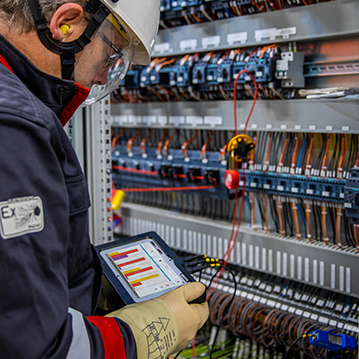
This range of courses aims to allow participants to acquire the technical knowledge which is useful to implement your monitoring programme for your production equipment. The field experience of Dynae, which is independent of the manufacturers, will give you many practical examples, which will allow you to understand good practices and help you avoid pitfalls.
CM COURSE - Conditional maintenance
Principle and implementation of the techniques used
Course developed in collaboration with IESPM
-
Duration
3 days
-
Prerequisites
None
-
Objectives
Acquire the knowledge necessary to implement and supervise a forward-looking maintenance policy based on multi-technical monitoring.
-
Target audience
Personnel involved in maintenance, mechanical and electrical methods and reliability.
-
Programme
- Equipment monitoring policy: summary and master plan to set up and optimise your strategy: analysis of requirements, objectives, organisation, means and procedures, economic aspect
- Principle, applications, implementation and organisation of the various monitoring techniques: vibration analysis, electrical analysis, infrared thermography, analysis of lubricants and ultrasound
- Applications on model: vibration measurements, use of the TIR camera
-
Personalised audit option
1 day on site
- Technical audit on site by an expert
- Analyse of requirements
- Advice on the optimal strategy
- Audit report
-
The advantages
- Training given in association with a specialist in IESP lubricants analysis
- The experience of multi-technical deployment for various industrial processes
IRT COURSE – Infrared thermography
Infrared thermography applied to condition-based maintenance
-
Duration
1 day on your premises
-
Maximum number of participants
6
-
Prerequisites
None
-
Trainers
APSAD D19 approved
-
Objectives
- Acquire the fundamentals of infrared thermography applied to condition-based maintenance
- Understand how a thermal camera works
- Understand and then master thermographic measurement situations in the industrial field
- Know how to interpret images and avoid traps
-
Target audience
Staff in charge of thermographic checks.
-
Programme
- Principle and generalities of infrared thermography
- Operating a thermal camera
- Industrial case studies
- Getting started with the thermal camera
- Scenario in the context of your own industrial facilities
- Pitfalls and mistakes to be avoided
-
The advantages
APSAD D19 qualified trainers who use infrared thermography on a daily basis
ELEC COURSE – Diagnosis of electrical equipment
Diagnosis techniques and applying them to condition-based maintenance
-
Duration
3 days
-
Prerequisites
None
-
Objectives
- Know the standard and innovative investigation methods used for the monitoring and diagnosis of electrical equipment: motors, generators, drives and speed controls, as well as how they interact with the network
- Use the spectral analysis of electric current for fault diagnosis on rotating machines
- Know how to implement a monitoring policy for your range of electrical equipment
-
Target audience
Electrical and energy department personnel: maintenance, methods, production.
-
Programme
- Reminder of the fundamental principles of electrical engineering
- Operating principle and technology of asynchronous, synchronous, direct current motors and generators
- Vibratory and electrical symptoms and diagnosis rules
- Power supply, excitation and regulation, influence of the network
- Equipment, carrying out measurements and analyses
- Monitoring methodology
- Illustration on didactic model
- Indicators, thresholds and standards
- Industrial case studies on rotating machines and networks
-
The advantages
- Learning about advanced diagnosis techniques
- Three-phase didactic bench
- Training given by electricians performing daily diagnoses
SSV COURSE – Online vibration monitoring systems
Features and functions of continuous vibration monitoring systems
-
Duration
3 days
-
Prerequisites
None
-
Objectives
- Know how to define your requirements in terms of continuous vibration monitoring
- Know the main functions and characteristics of a vibration monitoring system
- Know how to draw up specifications and differentiate between offers
- Integration and configuration of the system on the site: communication, supervision, alarm management
-
Target audience
Personnel in charge of maintenance, methods, reliability and instruments
-
Programme
- Basics of vibration analysis, monitoring indicators, standards and thresholds
- Various functions of the vibration monitoring system: protection, monitoring, remote diagnosis
- Hardware and software inventory:
- Specificities related to the environment: ATEX, corrosive environment, extreme temperatures,...
- Sensors: accelerometers, proximity probes, temperature probes, wireless technology, etc.
- Electronics: synchronism, technologies, reliability...
- Software
- Communication methods (office automation protocols, production, etc.)
- Installation & configuration: basic EMC rules, vendor / installer dissociation or turnkey purchase.
- Human organisation around the monitoring system:
- Managing the monitoring system and required skills
- Examples of organisation on various sites
- Maintenance of the monitoring system: maintenance management (response and procurement times, etc.), diagnosis of a measurement chain fault, interference, etc.
-
The advantages
- Innovative DYNAE training course resulting from our experience as an integrator
- Non-captive training course of a manufacturer
- Gives effective tools to make the right technical choices

